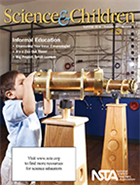Lemonade Stands and Summer Activity Resources
By Peggy Ashbrook
Posted on 2014-07-09
Thanks to a teacher who was moving and in a new job, I received boxes of resources from Zoobooks to CESI publications to posters that will interest children and convey concepts today as well as they did 30 years ago—sorting by an attribute and measuring will always be important in science education. Many of the posters showed families doing things together, emphasizing the role that parents and other adult family members play in children’s education.
 Now that the weather is hot, I see evidence of family support for science and math learning, and review, on neighborhood street corners in the form of lemonade stands. “Made from scratch” lemonade requires cutting open fruit, squeezing the juice out of all the little vesicles in the lemons, measuring water and sugar, and stirring to mix it all together. With a magnifier, children can make close observations of the structure of a lemon, looking closely at the seeds and juice-holding vesicles, and at grains of sugar. Even very young children can learn vocabulary words, “wet” and “dry,” “liquid” and “solid,” and “dissolve.” By making careful observations, children can notice that the sugar
Now that the weather is hot, I see evidence of family support for science and math learning, and review, on neighborhood street corners in the form of lemonade stands. “Made from scratch” lemonade requires cutting open fruit, squeezing the juice out of all the little vesicles in the lemons, measuring water and sugar, and stirring to mix it all together. With a magnifier, children can make close observations of the structure of a lemon, looking closely at the seeds and juice-holding vesicles, and at grains of sugar. Even very young children can learn vocabulary words, “wet” and “dry,” “liquid” and “solid,” and “dissolve.” By making careful observations, children can notice that the sugar  “disappears” as they stir, and by tasting, they can find out if the sugar is “still in the pitcher.” A mini lecture on the dissolution of a solid into a liquid might not be memorable but children will remember if they can continue the exploration into which common and safe solids will dissolve into which common and safe liquids. Salt, sand, baking soda, cornstarch and flour are possibilities to pair with water, vegetable oil and apple juice (it is easier to see any undissolved solids in clear liquids). Provide measuring tools such as teaspoons, measuring cups, and timers (how long did it take the sugar to dissolve?), and a way to document the results, by drawing, dictation or photography. Adult support is also valuable to help children think about what they did. Asking open-ended questions will encourage children to wonder and say what they think is happening. “What do you see?” “Tell me about any changes you see happening.” “How much of the solid do you see in the container?” “How many minutes did it take for the sugar to dissolve?” and “Do you think the sand will dissolve by tomorrow?”
“disappears” as they stir, and by tasting, they can find out if the sugar is “still in the pitcher.” A mini lecture on the dissolution of a solid into a liquid might not be memorable but children will remember if they can continue the exploration into which common and safe solids will dissolve into which common and safe liquids. Salt, sand, baking soda, cornstarch and flour are possibilities to pair with water, vegetable oil and apple juice (it is easier to see any undissolved solids in clear liquids). Provide measuring tools such as teaspoons, measuring cups, and timers (how long did it take the sugar to dissolve?), and a way to document the results, by drawing, dictation or photography. Adult support is also valuable to help children think about what they did. Asking open-ended questions will encourage children to wonder and say what they think is happening. “What do you see?” “Tell me about any changes you see happening.” “How much of the solid do you see in the container?” “How many minutes did it take for the sugar to dissolve?” and “Do you think the sand will dissolve by tomorrow?”
 The July 2014 issue of Science and Children has a collection of articles on informal science experiences, including the free article, Channeling Your Inner Entomologist by Tara C. Bell and Tara A.W. McGill, and my Early Years column about inviting parents to school and making lemonade from scratch. Kids Gardening has an article about beneficial insects, those “that behave in ways that are helpful to the crops we grow.”
The July 2014 issue of Science and Children has a collection of articles on informal science experiences, including the free article, Channeling Your Inner Entomologist by Tara C. Bell and Tara A.W. McGill, and my Early Years column about inviting parents to school and making lemonade from scratch. Kids Gardening has an article about beneficial insects, those “that behave in ways that are helpful to the crops we grow.”
Children who get to explore through programs at museums, nature centers, aquariums and parks or on family trips to the backyard or across country are exposed to science concepts in ways that go beyond what is possible in the classroom.
Where or how do you suggest children and their families extend their science learning?
Disclaimer: The views expressed in this blog post are those of the author(s) and do not necessarily reflect the official position of the National Science Teaching Association (NSTA).

